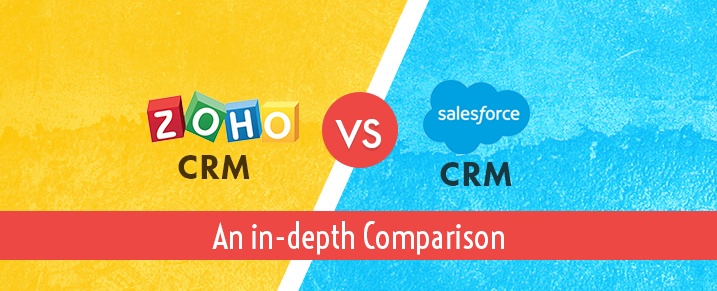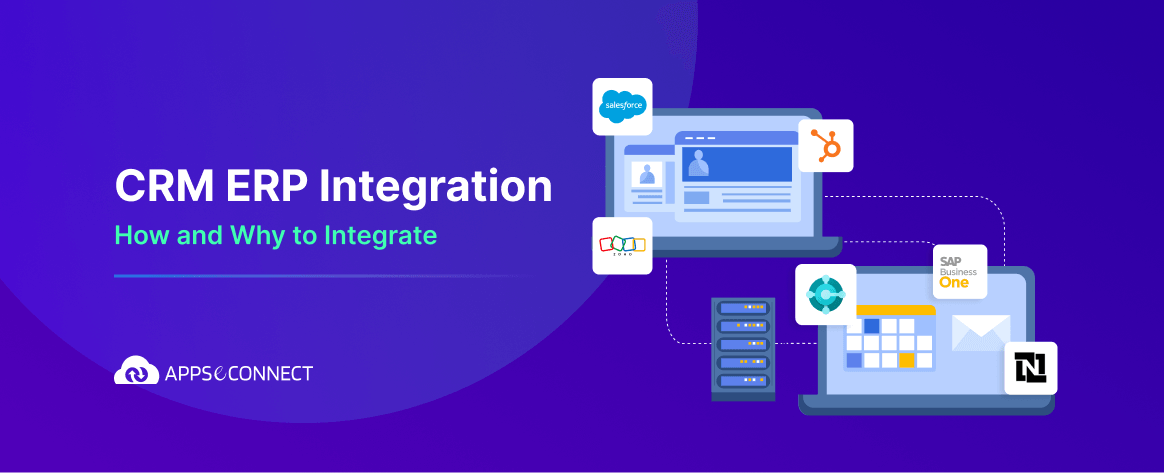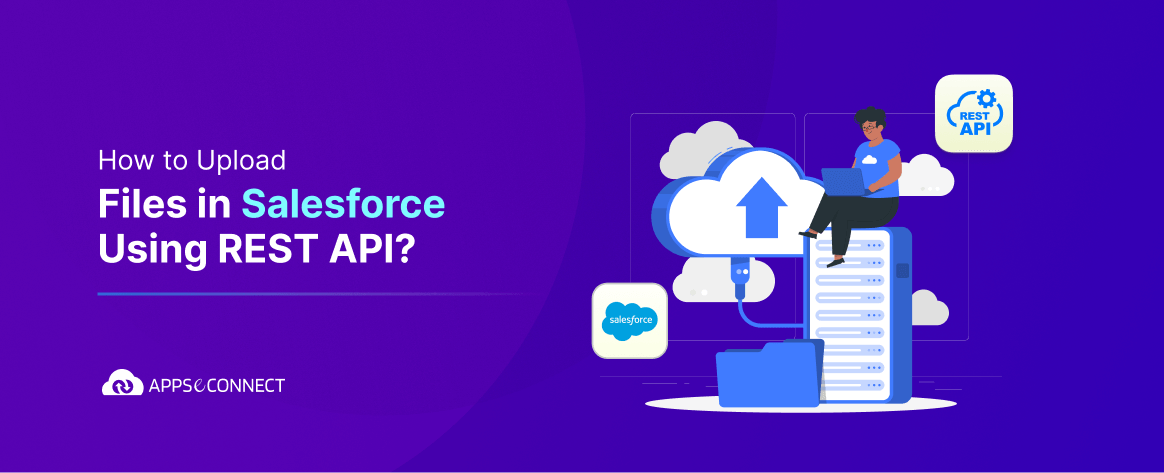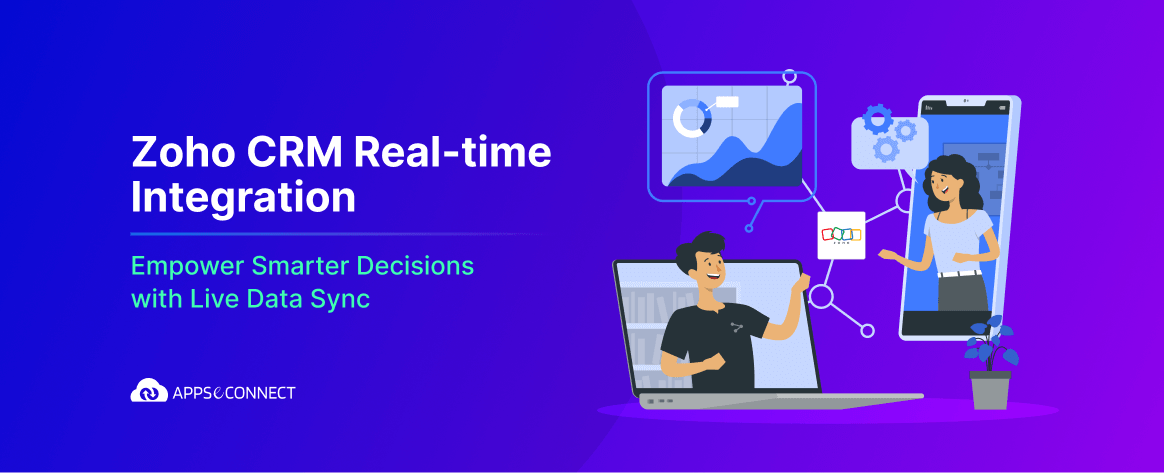
A few days earlier, one of our clients asked us , “ We are facing some issues in managing our customers and prospects. I am searching for a CRM and currently, I am evaluating both Salesforce and Zoho CRM. Which one would you recommend me? Which one is better?”
This is a common enough question which we face from our prospects and existing customers alike. As an Integration Platform, we have this wonderful opportunity to work with various platforms across a wide array of segments, from eCommerce, CRMs, Marketplaces, Shipping solutions, etc. and evaluate how one platform stacks up against the other in the same segment. For an online business, should you opt for Magento or Shopify or some other solution – What benefits are you deriving for your business? For a CRM, how can we compare Salesforce vs Dynamics CRM vs Zoho CRM vs Sugar CRM and the queries continue.
In today’s blog post, I will cover this vital question for many organizations: “Should we choose Salesforce or Zoho CRM?”
For each & every business, Customers are your biggest asset. You need to understand your customers, keep in mind their requirements and pain points. Then only you can provide them a solution and show them a way on how you can add value to their lives and businesses. However, unless and until, you have sufficient clarity on your customers and prospects, it won’t yield much return. Here’s where a CRM becomes essential to the growth of an organization – to manage your potentials, to maintain your customer data, to track possibilities, to prevent loss of data when employee leaves and the list is endless.
So, let’s stack Zoho CRM and Salesforce against each other and see how they rank.
1. Ease of Use:
a. Zoho CRM with its clean layout, modular approach is easier to use and configure. The current Zoho CRM UI is easily navigable, and you can effortlessly filter your data based on Potential Amount, Potential Stage, Closing date, Country and numerous others. In short, it feels like Zoho has done their proper research on how Sales Reps need to view their data. The learning curve is much simpler, so it is easy to get a hang of the CRM quickly.
b. The UI of default Salesforce is comparatively not as user-friendly as Zoho. Salesforce with its multitude of features can be somewhat harder to navigate and bit intimidating for a CRM novice. Ensure that your Reps get proper training on CRM usage, else efficient adoption rate may be low.
2. Features:
Both Salesforce and Zoho CRM are robust systems and they pack in loads of amazing features. While their basic CRM functionalities like Lead Management, Account Management, etc are similar, we were more interested in seeing the additional features or depth of features they bring to the table.
Let’s have a look at some of their more popular features:
| Salesforce Sales Cloud | Zoho CRM |
| Web-to-Lead: If you have a ‘Contact Us’ form in your website to catch enquiries, Salesforce automatically creates a Lead record from this form. | Web-to-Lead : Capture website visitor information directly in CRM and with assignment rules, assign the Lead directly to a Sales Rep. |
| Branded Email Templates and Insights: Keep a stack of pre-scripted templates (with or without attached documents) for general and frequent communications, like the introductory mail when someone fills up your website form. Track in Salesforce when the email was received and opened | Email Templates and Insights : Similar functionality like that provided by Salesforce. With Template Analytics track Open Rate, Click Rate, Bounce Rate of these emails in Zoho CRM. |
| Salesforce for Outlook: Emails sent from your email clients, like Outlook, Gmail, etc, can be directly synced to Salesforce via plugins. | Zoho CRM for Outlook: Similar plugins are available for directly syncing emails from Outlook and other email clients to Zoho CRM |
| Salesforce1 Mobile App : Securely access, create and update your Salesforce records when you are on-the-go directly from this app. Data can be accessed even when you are offline. | Zoho CRM Mobile App : Access, create and update all CRM records via this mobile app. Data can be accessed when offline. |
| Chatter: To connect and engage all employees together. Connect product teams with direct feedback from customer. Share knowledge and files. | Connect : Connect for team collaboration and share documents with your colleagues. |
| Enhanced Dashboard to sort and arrange information like your sales data, as per your needs and view critical business metrics. | Customizable Reports and Dashboard in all modules to give real-time snapshot of your key metrics. |
| ———– | SalesSignals: Helps to keep Sales reps updated in real time on customer interaction across social media, satisfaction surveys, support tickets, etc. |
| Salesforce Inbox : Enter new opportunities right from inbox, share calendar directly with customers to schedule a time | SalesInbox: Your emails are automatically organized and prioritized based on your sales pipeline and stage, thus allowing you to focus more on the deals likely to bring in revenue. |
| Numerous apps are available in Salesforce Appexchange for this. | SalesIQ : You can track website visitors ( repeated vistors can be tracked and follow ups can be planned ), chat widget, customer database . A separate product, offers integration with Zoho CRM |
| Lightning Dialer: Manage inbound and outbound calls to prospects directly from Salesforce, set reminders & automatically log calls. | Telephony: Zoho Phonebridge allows to make inbound, outbound calls from Zoho CRM, get reminders and add call details during call. |
| Lightning Dialer Voicemail Drop: Prerecord a generic message and leave a voicemail for a list of similar prospects. | ——- |
| Sales Cloud Einstein Artificial Intelligence: Lead Scoring – Start with the hottest leadsActivity Capture – Connect email and calendar to Salesforce, bypassAccount Insights – See key developments in your Accounts to build richer relationships.Opportunity Insights shows the hottest deals.Add Einstein features to Sales Cloud at USD 50/user/month. |
Zia Artificial Intelligence – lets you know the best time to call/email a contact, Trend analysis – View key business metric trends and be notified of anomalies, Macros Suggestion based on your CRM activities, Manage workflow |
| Importing and Exporting Data: Import up to 50,000 records at a time via Data Import Wizard. | Importing and Exporting Data: Data can be transferred from and to Zoho CRM. |
| Pull a feed of your customer’s social content to understand what they are saying about your products and uncover insights into customer issues. | Zoho Social- helps to gauge customer engagement across your social media channels and helps you to schedule your posts. One brilliant use: Set your Facebook posts by location and schedule them to go live at the same time of the day in different time zones. |
| Set Workflows with workflow rules to perform various activities like sending email alerts, updating records. Process Builder to create whole process in one place with point & click rather than using multiple workflow rules. | Automate workflow procedures and set up automatic replies, alerts and notifications in advance. |
| Salesforce offers a separate product Marketing Cloud with dedicated marketing features. License costs are separate. | Zoho is an all-in-one CRM. Provides basic marketing features like campaign management, email marketing, Web forms to Leads/Cases in the CRM itself. |
| Salesforce offers a separate application Service Cloud with social customer support features. License costs are separate. | While Zoho has other products dedicated to customer service like Zoho Desk, Zoho CRM offers a basic Customer Support and Service management features for tickets (cases), knowledge base, case assignment and escalation. |
As you can see, most of the features provided by both CRMs are similar, but in some cases, Salesforce provides more depth in the default offerings. Also, it is easier to customize Salesforce, so you can tweak the base features to suit your business process.
3. Ease of customization:
Both solutions come with amazing out-of-box features. However, no two businesses are same and the processes they follow are likely to vary too. Herein comes the need to modify and extend the default functionalities, to make the CRM do what’s best for your business. Both CRMs are flexible and customizable.
a. With Zoho, you can customize standard modules and add additional functionalities in those modules, create new modules, add custom fields, design layout, edit permissions.
b. Similarly, Salesforce can be configured as well as customized. While the Admin can make point-and-click changes via the Force.com builder (configuration), sometimes you need to extend/add new functionalities. This is done by technical experts via adding Apex Code or Visualforce pages (customization). The greatest strength of Salesforce is its customizability – custom fields, objects, 3rd party extensions, integrate your own apps, etc. to provide you a complete solution.
4. Pricing
Pricing is a major aspect why many organizations are opting for Zoho CRM instead of Salesforce. Let’s look into the ‘why’.
a. Zoho CRM has four Editions – Standard, Professional, Enterprise and Ultimate – starting from $12 to $100, charged per user/month billed annually. Their most popular plan is the Enterprise Plan, priced at $35/user/month billed annually.
b. Salesforce’s Sales Cloud also has four Editions – SalesforceIQ Starter, Lightning Professional, Lightning Enterprise and Lightning Unlimited – starting from $25 to $300, billed annually for per user/month. Their Enterprise Edition priced at $150/user/month ( billed annually) boasts of the maximum number of subscribers.
5. Contract:
a. With Zoho’s flexible and no-contract pricing model, you can purchase your Zoho licenses on a month-to-month basis and any time you wish to terminate the services, you can just do so, without any hassle or any termination fees. If the License payment is done on an annual basis, Zoho will offer you a discounted rate. Depending on your business demand and growth, you can upgrade or downgrade your plan anytime.
b. For Salesforce, you will have Annual Contracts, so you know exactly what you will be paying now and in the future and if you opt for a multi-year contract, Salesforce will offer a discounted rate. It is reported that Termination of Contract poses some difficulties and you may have to pay some termination fees. Your Salesforce contact is the best person to guide you here.
6. Customer Support and Training
a. Zoho has a dedicated Support Portal https://help.zoho.com/portal/zohocorp/home where one has access to the online user guides, developer guides, videos, forums and a complete knowledge base along with community support, email support. Technical support is included in the monthly license fee and is available via email for 24 hours a day from Monday-Friday.
b. Salesforce – A dedicated Technical Support Portal https://help.salesforce.com/support with free access to limited videos, FAQs, webinar. You can also post your queries to a strong community of Salesforce experts. Toll free support for 8am-8pm. 24/7 toll free support is payable in Professional and Enterprise edition, already included in License cost for Unlimited edition.
Salesforce University offers Training ( based on Roles and the Cloud Service you choose ) and Certification . You can also avail the Success Plans which include success resources, training and support to maximize benefits from your CRM.
7. Trial
a. You can access a free Trial of Zoho CRM for 15 days for all Editions from here: https://www.zoho.com/crm/lp/signup.html
b. Salesforce also offers a free Trial of Sales Cloud for 30 days, accessible here: https://www.salesforce.com/form/signup/freetrial-sales.jsp
8. Business Suite:
a. Zoho boasts of a complete suite of business applications to provide you a wholesome experience – Zoho Campaigns’ email marketing, Zoho’s own project management system aka Zoho Projects, Zoho Support for customer support and satisfaction, Zoho Survey for customer feedback, Zoho Reports for BI analytics, Zoho Invoice, etc.
b. Similarly other than Sales Cloud, Salesforce offers an array of solutions to increase productivity and earn higher revenue – Service Cloud and Desk.com to anticipate and cater to customer needs, Marketing Cloud and Pardot to build 1-o-1 customer journeys and drive sales, Analytics to deliver customizable insights and gain deeper understanding of your team’s performance, etc.
9. Customers:
a. Zoho boasts of having over 300,000 organizations which manage their daily operations via Zoho CRM. Here are some they have showcased: https://www.zoho.com/crm/customers/
b. While Salesforce claims to have around 150,000 customers, see for yourself how their customers rate them: https://www.salesforce.com/customer-success-stories._filter.popularSort/
10. Marketplace and integration with other Apps:
a. Zoho’s newly launched Marketplace, https://marketplace.zoho.com/ offers a host of integrations for 3rd-party apps like MailChimp, Quickbooks, DocuSign, etc. With Zoho Developer, you can create custom extensions and applications. Add more feature to your CRM via Native integration with Zoho’s Business Suite – Zoho Campaigns, Zoho Projects, Zoho Support, Zoho Survey, Zoho Reports, Zoho Invoice and others. Your CRM can also be integrated with Google Apps to perform functions like syncing tasks to Google Calendar, attaching files to Google Drive and others.
b. Salesforce AppExchange, https://appexchange.salesforce.com/ is the business app store with 2800+ apps ( free + paid ) including integrations with MailChimp, Xero, Quickbooks, DocuSign, AdobeSign, etc for small and enterprise businesses in one platform.
There is also Lightning Exchange for parts of an application or page that customers and partners want to build/ customize using the Lightning App Builder. Also, the other Salesforce products like Marketing Cloud, Service Cloud and others have default integration with Sales Cloud.
11. Web APIs for Integration with other Systems :
a. Web Service APIs for integrating with other platforms are available for all Zoho Plan. The number of API Calls in the Professional Plan is comparatively lesser than the Enterprise Plan, so opt for the Zoho Plan based on your data volume.
b. Web Service APIs for Salesforce are included for Enterprise and Unlimited plan only. If you opt for lesser plans, you need to purchase Web Service APIs Package.
While Zoho CRM had been previously categorized as the CRM for small businesses which require basic CRM functionalities, Zoho has come up with some major functionalities in 2016 and is competing strongly with Salesforce.
Salesforce has reigned as the market leader in the CRM industry for many years and is still leading the CRM Market, per Gartner. Thrice every year they come up with some new feature releases to drive their reputation for product functionality and customer satisfaction.
While both solutions are similar in many ways, there are of course differences which give them an edge over the other. Both have matured, actively listened to customer feedback and have incorporated many functionalities which helps you as an organization to run your business more effectively. As time passes, we will look forward to further innovations and awesome features from them.
Any CRM you choose, it should be able to meet your business needs. Don’t choose a CRM just for its fancy features, choose a CRM which reflects your current business needs and your future ones too.
You may also like:
Dynamics CRM vs Salesforce CRM – A Comparison
Zoho Introduced Amazon Connect Integration in Business Apps
20 Ways CRM Is Going to Change Lead Generation in 2018



















